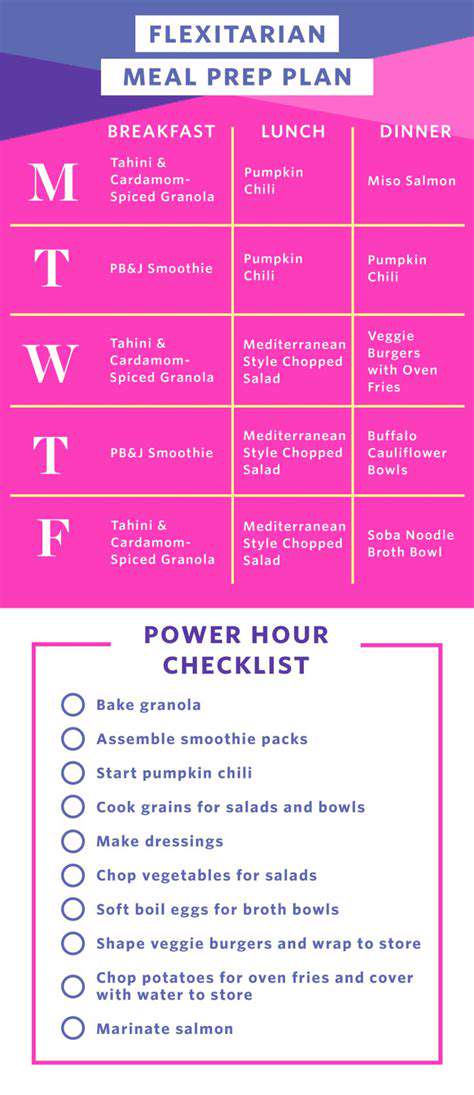
Building Your Weekly Flexitarian Shopping List
Planning Your Protein Powerhouses
A key element of a successful flexitarian diet is ensuring you're getting enough protein to support your body's needs. When creating your weekly shopping list, consider a variety of protein sources beyond just meat. This could include beans, lentils, tofu, tempeh, nuts, seeds, and Greek yogurt. Planning for protein-rich meals throughout the week, like lentil soup on Monday or a tofu scramble on Wednesday, ensures you're meeting your daily protein goals without relying solely on animal products. Incorporate these options into your menu to ensure you're not only eating delicious and nutritious foods but also meeting your body's protein requirements.
Variety is crucial. Don't just rely on the same few protein sources each week. Explore different types of beans, experiment with different tofu preparations, or try a new nut or seed butter. This variety will not only keep your meals interesting but also ensure you're getting a wider range of essential amino acids and other beneficial nutrients.
Grabbing Your Greens and Veggies
Vegetables are the cornerstone of a healthy diet, and a flexitarian lifestyle emphasizes their importance. When building your weekly shopping list, make sure to include a colorful array of vegetables. Think leafy greens like spinach and kale, root vegetables like carrots and beets, cruciferous vegetables like broccoli and cauliflower, and vibrant options like bell peppers and tomatoes. Aim for at least 5 servings of vegetables per day, and incorporate them into your meals in creative ways. Roast them, sauté them, or add them raw to salads.
Choosing Whole Grains and Healthy Carbs
Whole grains provide essential fiber and complex carbohydrates, which are crucial for sustained energy and digestive health. Include options like brown rice, quinoa, oats, and whole-wheat pasta in your weekly shopping list. These grains can be the base of many flexitarian meals, such as a hearty grain bowl or a satisfying veggie-packed pasta dish. By choosing whole grains, you're not just fueling your body but also supporting a healthy gut microbiome.
Don't shy away from creative uses of whole grains. Experiment with different types of grain-based dishes, such as grain salads or grain-based burgers. This will add variety to your meals and keep you excited about your flexitarian journey.
Considering Fruits for Sweetness and Vitamins
Fruits are an excellent source of vitamins, minerals, and antioxidants. Include a variety of fruits like berries, apples, bananas, oranges, and melons in your weekly flexitarian shopping list. Fruits can be enjoyed as snacks, added to smoothies, or incorporated into desserts and meals. For example, sliced peaches added to a savory quinoa dish can add a touch of sweetness and a burst of flavor.
Consider seasonal fruits for the best flavor and value. Supporting local farmers' markets or choosing fruits in season can help you save money and enjoy the freshest, most flavorful options. They also help reduce your carbon footprint by supporting sustainable practices.
Snacking Smart for Healthy Choices
Snacks are an important part of maintaining energy levels and preventing overeating at mealtimes. Include healthy snack options in your weekly shopping list, such as nuts, seeds, fruits, vegetables, and whole-grain crackers. These snacks provide sustained energy without the added sugar or unhealthy fats often found in processed snacks. For example, a handful of almonds or a small apple can satisfy your cravings while keeping you on track with your healthy eating goals.
Avoid relying on processed snacks. Instead, opt for natural, unprocessed foods that provide sustained energy and essential nutrients. This will help you stay full and energized between meals, avoiding cravings and unhealthy choices.
Before administering any medication to your pet, it's crucial to prepare both yourself and your furry friend for the process. A calm and controlled environment is key. Minimize distractions such as loud noises or other pets. Ensure you have all the necessary supplies readily available, including the medication, measuring tools (if required), and a comfortable place to hold your pet. This proactive approach will help to ensure a smooth and stress-free experience for everyone involved, minimizing any potential fear or anxiety your pet may experience.